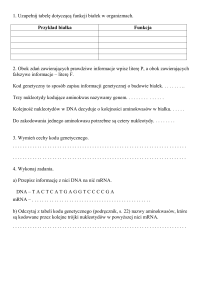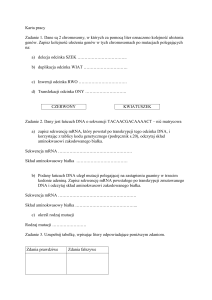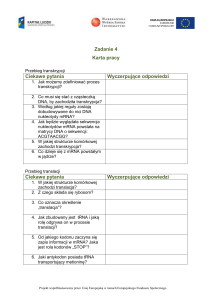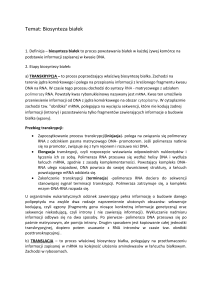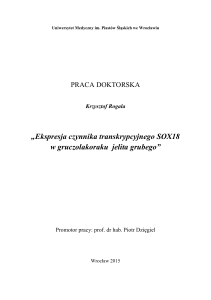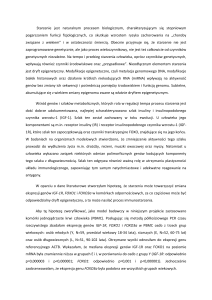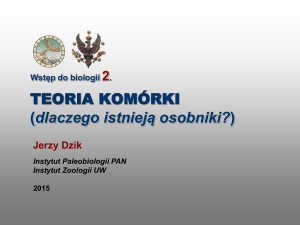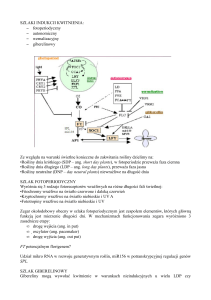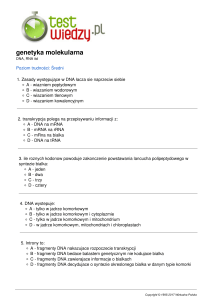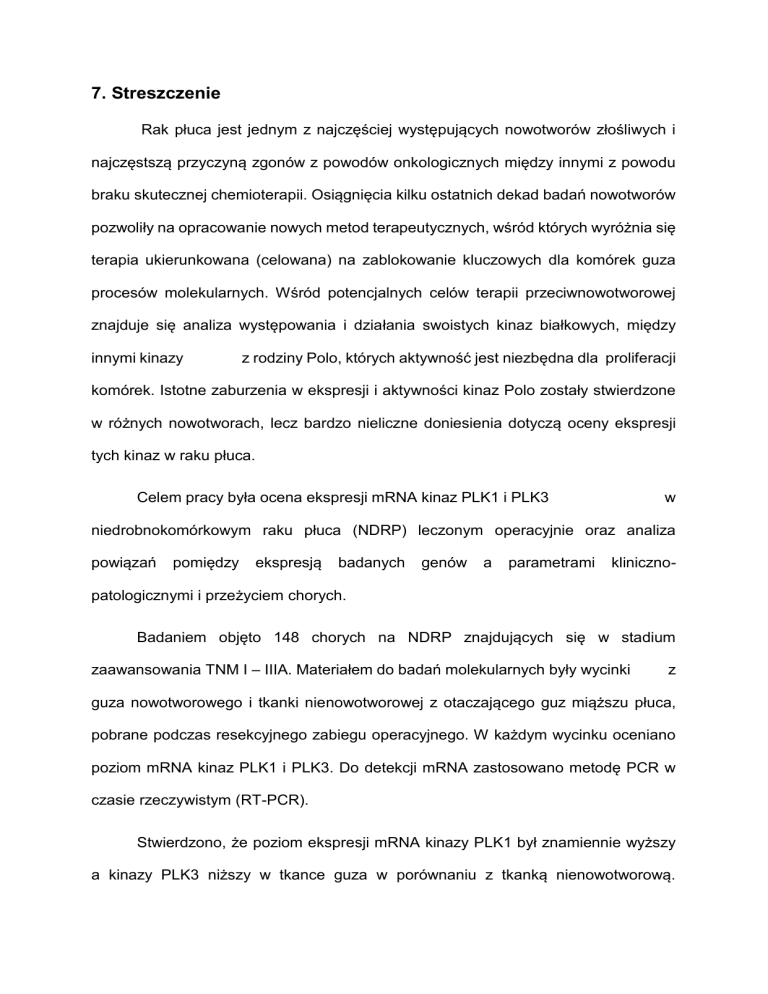
7. Streszczenie
Rak płuca jest jednym z najczęściej występujących nowotworów złośliwych i
najczęstszą przyczyną zgonów z powodów onkologicznych między innymi z powodu
braku skutecznej chemioterapii. Osiągnięcia kilku ostatnich dekad badań nowotworów
pozwoliły na opracowanie nowych metod terapeutycznych, wśród których wyróżnia się
terapia ukierunkowana (celowana) na zablokowanie kluczowych dla komórek guza
procesów molekularnych. Wśród potencjalnych celów terapii przeciwnowotworowej
znajduje się analiza występowania i działania swoistych kinaz białkowych, między
innymi kinazy
z rodziny Polo, których aktywność jest niezbędna dla proliferacji
komórek. Istotne zaburzenia w ekspresji i aktywności kinaz Polo zostały stwierdzone
w różnych nowotworach, lecz bardzo nieliczne doniesienia dotyczą oceny ekspresji
tych kinaz w raku płuca.
Celem pracy była ocena ekspresji mRNA kinaz PLK1 i PLK3
w
niedrobnokomórkowym raku płuca (NDRP) leczonym operacyjnie oraz analiza
powiązań
pomiędzy
ekspresją
badanych
genów
a
parametrami
kliniczno-
patologicznymi i przeżyciem chorych.
Badaniem objęto 148 chorych na NDRP znajdujących się w stadium
zaawansowania TNM I – IIIA. Materiałem do badań molekularnych były wycinki
z
guza nowotworowego i tkanki nienowotworowej z otaczającego guz miąższu płuca,
pobrane podczas resekcyjnego zabiegu operacyjnego. W każdym wycinku oceniano
poziom mRNA kinaz PLK1 i PLK3. Do detekcji mRNA zastosowano metodę PCR w
czasie rzeczywistym (RT-PCR).
Stwierdzono, że poziom ekspresji mRNA kinazy PLK1 był znamiennie wyższy
a kinazy PLK3 niższy w tkance guza w porównaniu z tkanką nienowotworową.
Ekspresja mRNA PLK1 była najwyższa w rakach wielkokomórkowych i w guzach
niezróżnicowanych lub słabo zróżnicowanych oraz w stadium zaawansowania IIIA
nowotworu.
Spadek
ekspresji
genu
PLK3
był
największy
w
rakach
płaskonabłonkowych oraz w II stadium zaawansowania choroby w porównaniu z
chorymi w stadium I.
Wykazano zależność pomiędzy występowaniem mutacji aktywującej onkogen
KRAS a ekspresją mRNA PLK1 oraz brak takiej zależności dla ekspresji mRNA PLK3.
Zmiany w ekspresji mRNA PLK1 i PLK3 nie miały znaczenia prognostycznego
w całej grupie chorych na NDRP po leczeniu operacyjnym.
Z kolei u chorych na
raka gruczołowego i wielkokomórkowego zachowany poziom ekspresji PLK3 był
niezależnym pozytywnym czynnikiem prognostycznym.
Przeprowadzone badania wykazały, że w procesie kancerogenezy w płucu
zachodzą istotne zmiany w aktywności genów kinaz z rodziny POLO - PLK1
i
PLK3, a ich nasilenie zależy od cech kliniczno-patologicznych NDRP. Poziom
ekspresji PLK3
może mieć znaczenie rokownicze dla wyselekcjonowanych grup
chorych na NDRP.
8. Abstract
Lung cancer is the most common type of malignant cancer which causes death
of patients for the lack of proper chemotherapy. The advances of the last few decades
have enabled to develop new, more effective therapeutic methods for treating patients
with lung cancer. There is one method among them which
is particularly useful
because it is aimed at blocking addictive molecular processes inside tumor cells
(targeted therapy). Among many possible objectives
of antineoplastic therapy,
one focuses solely on the specific activity of protein kinases, e.g. Polo kinases, which
is essential for the proliferation of cells.
The important disorders of Polo
kinases expression and activity have already been observed and reported in a variety
of tumours. However, very few findings concerning the evaluation of the
aforementioned kinases in lung cancer have yet been documented.
The aim of this dissertation is the evaluation of mRNA expression PLK1 and
PLK3 in non-small cell lung carcinoma (NSCLC) treated by operation as well as the
analysis of connections between the expression of analysed genes and both clinical
and pathological parameters with the relation to the overall patients’ survival rate.
The reaserch was based on 148 patients with NSCLC in TNM I-IIIA advanced
stage. Molecular material consisted of samples obtained during
the operation,
from both a cancer tumour and non-neoplasmatic lung tissue surrounding the tumour
itself. In each sample the level of mRNA kinases PLK1 and PLK3 was evaluated. The
RT-PCR method was used to detect mRNA.
As a result, it was observed that the level of mRNA kinases PLK1 was
considerably higher and, at the same time, the level of mRNA kinases PLK3
considerably lower inside the tumour tissue with the comparison to the non-
neoplasmatic tissue surrounding the tumour. The highest level of mRNA kinases PLK1
was detected in large cell carcinoma (LCC) as well as in non-differentiated or lowdifferentiated tumours. In addition, it was also observed in the stage IIIA
The decrease in expression of mRNA kinases PLK3 was the highest
planoepithelial types of cancer and at the stage II of cancer in comparison
of cancer.
in
with
patients in stage I.
Furthermore, it has been shown that there is dependence between
the
appearence of mutation activating oncogen KRAS and mRNA expression PLK1while
there is no such correlation for mRNA expression PLK3.
Changes in mRNA expression PLK1 and PLK3 have no predictive significance in
the whole group of NSCLC in post-operational treatment. Alternatively, for patients with
either adenocarcinoma or macrocellular carcinoma the diagnosed level of PLK3
expression remained an objective and positive prognostic factor.
The undertaken research has shown that during the inner lung cancerogenetic
process, some significant changes in activity of Polo kinases genes PLK1
and
PLK3 have been proceeding. Moreover, it may be concluded that
the
intensification of such changes is directly connected with NSCLC clinical-pathological
features. Therefore, the overall level of PLK3 expression may have its predictive
significance for selective groups of NSCLC patients.

